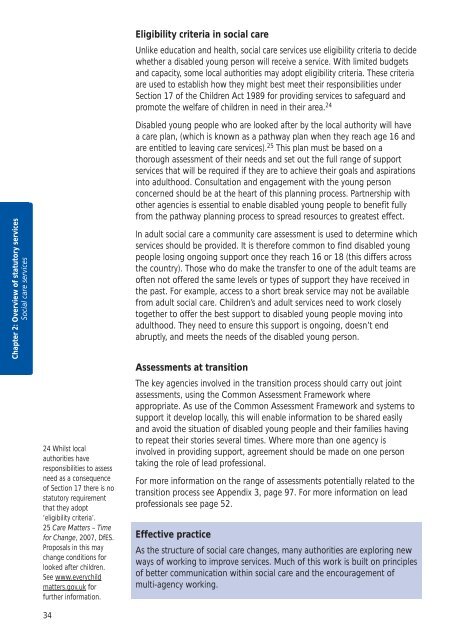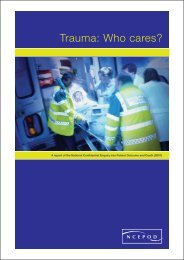A Transition Guide for All Services - Transition Information Network
A Transition Guide for All Services - Transition Information Network
A Transition Guide for All Services - Transition Information Network
- No tags were found...
You also want an ePaper? Increase the reach of your titles
YUMPU automatically turns print PDFs into web optimized ePapers that Google loves.
Chapter 2: Overview of statutory servicesSocial care services24 Whilst localauthorities haveresponsibilities to assessneed as a consequenceof Section 17 there is nostatutory requirementthat they adopt‘eligibility criteria’.25 Care Matters – Time<strong>for</strong> Change, 2007, DfES.Proposals in this maychange conditions <strong>for</strong>looked after children.See www.everychildmatters.gov.uk <strong>for</strong>further in<strong>for</strong>mation.34Eligibility criteria in social careUnlike education and health, social care services use eligibility criteria to decidewhether a disabled young person will receive a service. With limited budgetsand capacity, some local authorities may adopt eligibility criteria. These criteriaare used to establish how they might best meet their responsibilities underSection 17 of the Children Act 1989 <strong>for</strong> providing services to safeguard andpromote the welfare of children in need in their area. 24Disabled young people who are looked after by the local authority will havea care plan, (which is known as a pathway plan when they reach age 16 andare entitled to leaving care services). 25 This plan must be based on athorough assessment of their needs and set out the full range of supportservices that will be required if they are to achieve their goals and aspirationsinto adulthood. Consultation and engagement with the young personconcerned should be at the heart of this planning process. Partnership withother agencies is essential to enable disabled young people to benefit fullyfrom the pathway planning process to spread resources to greatest effect.In adult social care a community care assessment is used to determine whichservices should be provided. It is there<strong>for</strong>e common to find disabled youngpeople losing ongoing support once they reach 16 or 18 (this differs acrossthe country). Those who do make the transfer to one of the adult teams areoften not offered the same levels or types of support they have received inthe past. For example, access to a short break service may not be availablefrom adult social care. Children’s and adult services need to work closelytogether to offer the best support to disabled young people moving intoadulthood. They need to ensure this support is ongoing, doesn’t endabruptly, and meets the needs of the disabled young person.Assessments at transitionThe key agencies involved in the transition process should carry out jointassessments, using the Common Assessment Framework whereappropriate. As use of the Common Assessment Framework and systems tosupport it develop locally, this will enable in<strong>for</strong>mation to be shared easilyand avoid the situation of disabled young people and their families havingto repeat their stories several times. Where more than one agency isinvolved in providing support, agreement should be made on one persontaking the role of lead professional.For more in<strong>for</strong>mation on the range of assessments potentially related to thetransition process see Appendix 3, page 97. For more in<strong>for</strong>mation on leadprofessionals see page 52.Effective practiceAs the structure of social care changes, many authorities are exploring newways of working to improve services. Much of this work is built on principlesof better communication within social care and the encouragement ofmulti-agency working.
















